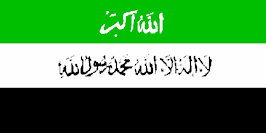Islamic Emirate of Afghanistan
Afghanistan - Taliban Era - 1995-2001
 There was no functioning central government in Afghanistan, following over two decades of civil war and political instability. The Pashtun-dominated ultra-conservative Islamic movement known as the Taliban eventually controlled approximately 95 percent of the country, including the capital of Kabul, and all of the largest urban areas, except Faizabad.
There was no functioning central government in Afghanistan, following over two decades of civil war and political instability. The Pashtun-dominated ultra-conservative Islamic movement known as the Taliban eventually controlled approximately 95 percent of the country, including the capital of Kabul, and all of the largest urban areas, except Faizabad.
A Taliban edict in 1997 renamed the country the Islamic Emirate of Afghanistan, with Taliban leader Mullah Omar as Head of State and Commander of the Faithful. An emirate is a political territory that is ruled by a dynastic Muslim monarch styled emir. It also means principality. An emirate is a subordinate part of the caliphate, if and when one exists. Either the Emir the Caliph might be described as Amir ul-Momineen – the commander of the faithful. There was a six-member ruling council in Kabul, but ultimate authority for Taliban rule rested in Mullah Omar, head of the inner Shura (Council), located in the southern city of Kandahar.
Former President Burhanuddin Rabbani, who claimed to be the head of the Government, controlled most of the country's embassies abroad, and retained Afghanistan's United Nations seat after the UN General Assembly again deferred a decision on Afghanistan's credentials during the September General Assembly session. Rabbani and his military commander, Ahmed Shah Masood, both Tajiks, also maintain control of some largely ethnic Tajik territory in the country's northeast.
Masood's forces were within rocket range of Taliban-held Kabul until late July 1999, but since then the Taliban had pushed them back, capturing large areas. In 1999 the Taliban summer offensive pushed Masood's forces out of the Shomali plain, north of Kabul. Towards the middle of June 2000, the Taliban resumed its offensive, and captured the northeastern city of Taloqan. Commander Masood and commanders under the United Front for Afghanistan (UFA), also known as the Northern Alliance, continue to hold the Panjshir valley and Faizabad. The UN Secretary General's Personal Representative to Afghanistan Fransesc Vendrell engaged in extensive discussions with various Afghan parties and interested nations throughout 2000, but there was little visible progress in ending the conflict. A group of representatives from the six nations bordering Afghanistan plus the United States and Russia met several times during 2000 to explore ways to end the conflict.
A number of provincial administrations maintained limited functions, but civil institutions were rudimentary. There was no countrywide recognized constitution, rule of law, or independent judiciary. The Taliban remained the country's primary military force.
Agriculture, including high levels of opium poppy cultivation, was the mainstay of the economy. For the second year in a row, in 2000 the country was the largest opium producer in the world. The agriculture sector suffered a major setback in 2000 due to the country's worst drought in 30 years. Experts estimated that the drought affected more than half of the population, with 3-4 million severely affected. The drought affected all areas of the country, causing an increase in internal displacement, loss of livestock, and loss of livelihood. The crop loss in some areas was estimated to be 50 percent. Approximately 80 percent of the livestock of the Kuchi nomads reportedly perished, and the Argun reservoir which supplied water to 500,000 farmers and to Kandahar ran dry, as did 8 rivers in the region. In addition to the drought, the agricultural sector continued to languish because of a lack of resources and the prolonged civil war, which had impeded reconstruction of irrigation systems, repair of market roads, and replanting of orchards in some areas.
The presence of millions of landmines and unexploded ordnance throughout the country restricted areas for cultivation and slowed the return of refugees who are needed to rebuild the economy.
Trade was mainly in opium, fruits, minerals, and gems, as well as goods smuggled to Pakistan. There were rival currencies, both very inflated. Formal economic activity remained minimal in most of the country, especially rural areas, and was inhibited by recurrent fighting and by local commanders' roadblocks in non-Taliban controlled areas. The country also was dependent on international assistance. Per capita income, based on World Bank figures, was about $280 per year. Reconstruction continued in Herat, Kandahar, and Ghazni, areas that were under firm Taliban control. Areas outside of Taliban control suffered from brigandage.
On December 19, 2000, the UN Security Council imposed additional sanctions against Afghanistan's ruling Taliban movement (which then controlled around 95% of the country), including an arms embargo and a ban on the sale of chemicals used in making heroin. These sanctions (Resolution 1333), which took effect in one month if the Taliban did not comply, were aimed at pressuring Afghanistan to turn over Osama bin Laden, suspected in various terrorist attacks, including the August 1998 US Embassy bombings in Kenya and Tanzania. These latest sanctions were in addition to sanctions (Resolution 1267) imposed on Afghanistan in November 1999, which included a freeze on Taliban assets and a ban on international flights by Afghanistan's national airline, Ariana. Afghanistan's government reacted sharply to the new sanctions, ordering a boycott of US and Russian goods, and pulling out of UN-mediated peace talks aimed at ending the country's civil war.
In the years leading up to the 11 September 2001 attacks in the United States, the Taliban provided a safe haven for al-Qa‘ida. This gave al-Qa‘ida a base in which it could freely recruit, train, and deploy terrorists to other countries. The Taliban held sway in Afghanistan until October 2001, when they were seemingly routed from power by the US-led campaign against al-Qa‘ida.
|
NEWSLETTER
|
| Join the GlobalSecurity.org mailing list |
|
|
|

